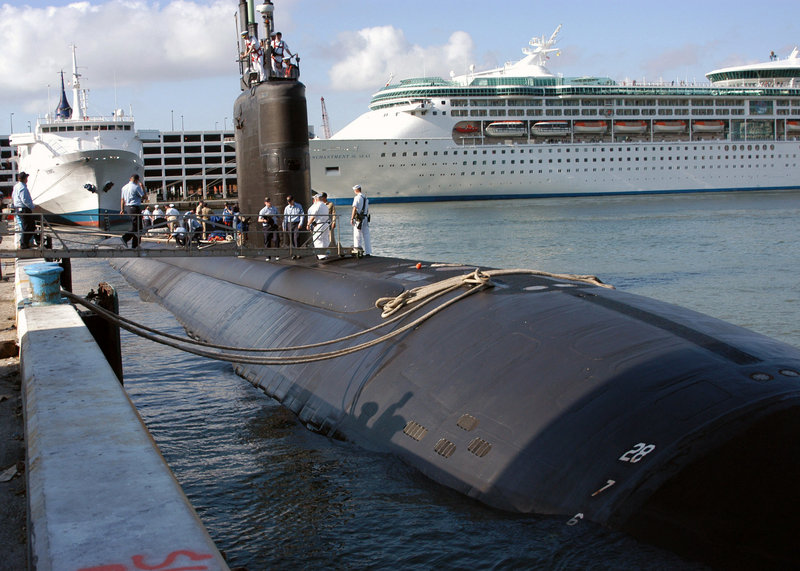KITTERY – Tom Mader remembers the USS Miami when it was a metal hull filled with shipbuilders putting the final touches on the nuclear-powered submarine at Electric Boat in Connecticut. He was the skipper when the submarine was commissioned in 1990.
As a plank owner — a Navy ship’s original crew member — he can’t help but be disappointed that the fire-damaged submarine is going to be cut up for scrap instead of going back to sea to serve its country.
“I can speak for all of the plank owners: It’s emotional for us to see one of the ships that we helped test and build and put to sea be laid to rest,” the retired Navy captain said from his home in Benicia, Calif.
Destined for premature retirement, the USS Miami will have an asterisk next to its name when it’s removed from the Navy’s rolls of active warships because an arsonist caused hundreds of millions of dollars of damage, effectively sinking the ship.
The blaze started in May 2012 when a shipyard worker set fire to a box of rags and grew into an inferno that took 100 firefighters 12 days to douse.
The submarine based in Groton, Conn., which was undergoing a 20-month overhaul, suffered severe damage to forward compartments including living quarters, a command and control center, and the torpedo room. Seven people were hurt.
Other warships have been lost during peacetime, including the Thresher and Scorpion, submarines that sank with the loss of all hands. And other ships were damaged so severely they had to be scuttled. This year, for example, a U.S. minesweeper had to be dismantled piece by piece after running aground in the Philippines.
But David F. Winkler of the Naval Historical Foundation in Washington said the Miami appears to be in a class of its own because of the extent of the arson damage. “While there have been cases of internal sabotage, to the best of my knowledge this may be the first time we lost a ship to such criminal activity,” he said.
The worker who set the fire said he was suffering from anxiety and wanted to leave work early. He’s serving a 17-year prison sentence.
“The most sickening part to me is that we didn’t lose this submarine due to enemy attack or terrorism. We lost it due to an American citizen wanting to leave work,” said David Padgett, another plank owner who’s retired and living in Mystic, Conn. “She was a good ship. She had a lot of good years left in her.”
With the Navy short of ships, and submarines in particular, the Pentagon originally wanted to repair the 23-year-old submarine and send it back to sea for five more deployments. But the $450 million repair grew to $700 million when new damage was discovered. The high cost, along with sequestration, combined to scuttle the repairs.
Rear Adm. Richard Breckenridge, director of undersea warfare, said the Navy wanted to return the Miami to sea for 10 more years. But the growing costs, the unknowns of such an ambitious project and sequestration led to a change of heart.
These days, the Los Angeles-class attack submarine remains in the same dry dock where the fire started. The submarine’s pressure hull remains intact and there’s no outward sign of the fire.
But for workers, especially firefighters, the blaze never goes away.
“The rest of our workforce had nothing to do with setting that fire, but we have to live with it. We have to live with it for the rest of our shipyard careers and our lives,” said Paul O’Connor, president of the Metal Trades Council, a union representing shipyard workers.
O’Connor said Congress bears part of the responsibility for the sub’s ultimate demise. The Navy would have proceeded with repairs if not for mandated budget cuts. “Sequestration has to end,” he said.
For now, the Miami’s crew remains in Kittery, but the sailors will eventually scatter to other posts, said Lt. Tim Hawkins, spokesman for Submarine Group 2 in Groton, Conn.
Shipyard workers will oversee the inactivation of the sub, including removal of the nuclear propulsion.
Then the vessel will be brought to Washington state to be cut up for scrap.
For Mader, it’s an inglorious end for the warship.
“Any time that you’ve worked aboard a ship and put a lot of personal energy into it, and you’ve sailed aboard it, you always have an emotional attachment to it,” he said.
Send questions/comments to the editors.



Success. Please wait for the page to reload. If the page does not reload within 5 seconds, please refresh the page.
Enter your email and password to access comments.
Hi, to comment on stories you must . This profile is in addition to your subscription and website login.
Already have a commenting profile? .
Invalid username/password.
Please check your email to confirm and complete your registration.
Only subscribers are eligible to post comments. Please subscribe or login first for digital access. Here’s why.
Use the form below to reset your password. When you've submitted your account email, we will send an email with a reset code.